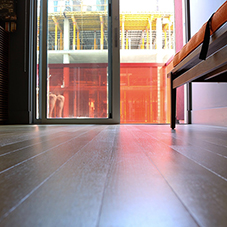This post is by Anders Berg at Underfloor Heating Systems, nationwide suppliers of wet underfloor heating systems.
A look into the efficiency of oil vs gas vs electric vs renewables
Underfloor heating (U.F.H.) has been steadily gaining in popularity over the last decade; a general increase in environmental awareness, the importance of cost-effectiveness at home and an appreciation of home comforts and luxuries all adding to this. It’s often claimed as a highly energy-efficient alternative to conventional radiators, yet, surf the home-improvement forums online and it won’t be long before you come across a disgruntled DIYer who might not agree.
A recurring theme amid the confusion is the overwhelming array of options. Between the various floor types, fuel sources, underfloor heating systems and manufacturers, it’s easy to get lost. Below, is compiled a run-down of the various merits of each and how to get the most out of your underfloor heating system.

The first choice facing any homeowner who is considering underfloor heating is whether to choose an electric or wet system. The running costs are quite different, with wet underfloor heating generally being more efficient, therefore cheaper to run. Where electric U.F.H. has the edge is in the installation. To install wet U.F.H. the floor will need to be taken up, re-cemented or a suspended floor built over the top of the existing floorboards to accommodate the pipes. Electric U.F.H. can be comfortably housed without raising the floor level more than a few centimetres. Thus, it becomes a question of longevity; will the savings over time offset the added cost and upheaval of installing a wet U.F.H. system? If the answer to that question is ‘Yes’ then a wet U.F.H. system is probably the better option.
With wet U.F.H, the most commonly used heat source is a gas or oil condensing-boiler, for concrete screed as well as timber suspended floors. A boiler is much cheaper to install than a heat pump, causes less disruption and modern boilers work to high efficiencies. For maximum output, this works best when set into a concrete screed floor. However, heating and cooling times are slower so you may have to run your system for longer, which reduces the impact of any savings on efficiency. Modern oil condensing boilers work well with U.F.H. but for the time being at least, running costs are lower when using gas (mains or LPG).
Wet U.F.H. can also work with electric boilers, which are best used in cases where there is no gas or oil. This might be remote or unusual properties for example, we recently supplied a system on a boat to be used with an electric boiler. Electric boilers can potentially take advantage of off-peak energy, there’s no flue either.

The most efficient wet U.F.H. system is a pairing of concrete screed floor construction and ground source heat pump. With a ground source heat pump as heat source and multilayer pipes in the floor, using a reliable mixing valve and manifold, you would have the optimum heating system available on the market today. Concrete is an efficient conductor and the relatively low temperatures associated with ground source heat pumps make them ideally suited to U.F.H, which works best at lower temperatures than wall-mounted radiators do.
A ground source heat pump will also work in timber suspended floors, but the coefficient of performance is much lower. Timber suspended floors need much higher water temperatures for the system to work, due to their construction, and a ground source heat-pump would struggle to provide the requisite levels of heat. Additionally, ground source heat pumps require a reasonably large area of land in which to be sunk, in many urban settings this won’t be possible, let alone practical, so your location should be taken into account too.
Properly considered, underfloor heating can be a good investment. Once you have considered your situation, your needs and circumstances and reached a decision on which set-up is right for you, you can enjoy the benefits of reduced carbon emissions, savings on your energy bills and the luxury of toasty-warm feet all year round.
Further information
For more information about Underfloor Heating Systems, please contact them on info@underfloorheatingsystems.co.uk
Related Blog Articles





